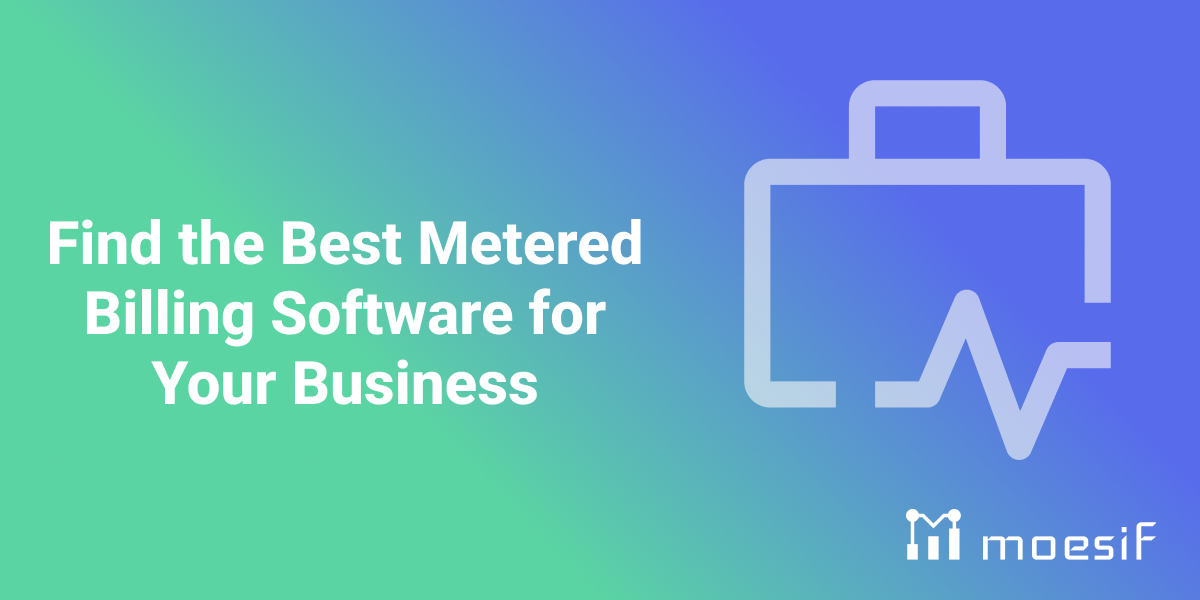Find the Best Metered Billing Software for Your Business

Did you know that 72% of SaaS companies plan to adopt usage-based pricing in the near future? It shows a growing demand for flexible, consumption-based billing models. If you want your business to stay ahead of the curve, you need the right tools to capitalize on this trend.
Metered billing aligns revenue with customer consumption. It offers numerous benefits like improved customer satisfaction, increased trust, and reduced churn. Customers appreciate the fairness and transparency of paying only for what they use.
This post explores metered billing software, a solution that helps implement usage-based pricing effectively. Discover how metered billing automates billing, boosts revenue visibility, and enhances customer satisfaction. We cover they key features to look for, evaluation criteria, and implementation steps to help you choose the best solution for your business.
At the end of this blog post, you’ll have a clear idea about optimizing your billing process to drive growth and monetization in the evolving subscription economy.

Table of Contents
- Table of Contents
- What is Metered Billing Software?
- Understanding Metered Pricing Structures
- Key Features of Metered Billing Software
- Evaluating Your Business Needs
- Researching and Comparing Metered Billing Software Options
- Implementing and Integrating Metered Billing Software
- Top Considerations for a Metered Billing Solution
- Conclusion
What is Metered Billing Software?
Metered billing software lets businesses charge customers based on actual product or service usage. Instead of a fixed monthly rate, customers pay for what they consume. This system works well for businesses with complex pricing structures or fluctuating usage patterns.
Definition and purpose of metered billing software
Metered billing software automates the entire billing process, from tracking customer usage to creating invoices. It eliminates manual calculation errors and saves time for your team. For example, SaaS companies can track API calls, storage use, or support tickets in real time. Accurate billing then happens automatically so that customers only pay for what they use.
Metered billing software aims to operationalize usage-based pricing models. Businesses can implement pricing strategies based on consumption, whether for cloud storage, software features, or digital services. It ensures consistent billing accuracy while supporting a scalable and flexible pricing system.
Benefits of using metered billing software for businesses
Metered billing software provides comprehensive insights into customer usage and revenue. Businesses can identify power users, track product demand, and adjust pricing strategies to increase profitability. For example, a cloud provider can notice higher data usage among enterprise customers and adjust pricing tiers to match demand.
This software also allows businesses to create flexible pricing models, such as tiered pricing or freemium plans. You can offer volume discounts or feature-based pricing to meet various customer needs. For example, a company offering communication APIs might charge more for high-volume customers while providing a free tier for low-usage clients.
Aligning billing with customer consumption boosts satisfaction and reduces churn. Customers appreciate paying only for the services they use. For example, an AI service offering machine learning model training can charge based on the number of training hours or the volume of data processed. It reduces the chances of customers feeling they are overpaying for unused features.
Ultimately, this approach fosters loyalty. Your relatively new customers soon become your long-time customers and therefore stable revenue sources for your business.
Understanding Metered Pricing Structures
Metered pricing structures provide the framework for charging customers based on their usage. These structures offer a high degree of flexibility and granularity. They allow you to tailor pricing to different customer segments and usage patterns. In this section, we look at tiered pricing, a popular metered pricing structure with a compelling combination of flexibility and predictability.
Tiered Pricing: A Flexible Billing Solution
Tiered pricing charges customers based on their usage within defined tiers. Each tier represents a range of consumption with a corresponding price. For example, a cloud service provider may charge one rate for users consuming up to 1 TB of storage, and a higher rate for customers exceeding that limit. This model adapts to various customer needs and thus offers a clear and scalable pricing structure.
With tiered pricing, businesses also has the power to influence customer behaviors. A cloud provider might offer discounts in higher tiers to encourage more storage consumption. Alternatively, businesses can promote responsible consumption by applying surcharges when customers exceed certain thresholds. These strategies help businesses optimize revenue and control resource usage.
Both customers and businesses can benefit from the predictability tiered pricing brings to the table. By clearly defining the usage limits and prices for each tier, businesses establish a transparent view of their services. Customers know in advance how much they bill they need to pay, helping them budget more effectively. A clear structure like this reduces billing disputes and improves customer satisfaction.
In AI services, you can see an example of tiered pricing in platforms offering natural language processing APIs. A business might charge a set rate for customers using up to 10,000 API calls per month, with increasing rates for higher usage tiers. This allows businesses with heavier usage to scale effectively while keeping entry-level costs low for smaller customers.
Key Features of Metered Billing Software
To select the right metered billing solution, you must understand the key features they come with and how they align with your business needs. In this section, we discuss two critical features: billing cycle management and usage rating and mediation.
Billing Cycle Management: Automating and Optimizing Your Billing Process
Billing cycle management automates the billing process with accuracy and timeliness. Metered billing software allows businesses to define billing cycles, such as monthly, quarterly, or annually, tailored to their customers’ preferences and business model. This flexibility simplifies the management of recurring payments by a large margin.
For example, a SaaS company can set up automatic invoice generation. The software calculates charges based on customer usage, generates invoices, and delivers them at scheduled intervals. This automation reduces manual work, prevents errors, and ensures timely payments.
Metered billing software also offers real-time visibility into billing operations. Businesses can track upcoming billing cycles, monitor pending invoices, and forecast revenue. You get the valuable insights that can improve financial planning and help identify issues before they affect revenue collection.
Usage Rating and Mediation: Ensuring Accurate Billing for Complex Models
Usage rating and mediation guarantee accurate billing in metered models. The software tracks customer usage, applies pricing rules, and calculates charges based on consumption. It supports advanced pricing models, including tiered pricing and volume discounts, so that businesses can implement flexible billing strategies.
Consider a company providing AI-driven natural language processing (NLP) APIs for enterprises. These APIs allow users to process text for tasks like sentiment analysis, entity extraction, and document summarization. The company charges based on a combination of factors: the volume of text processed, the complexity of the task (for example, translation versus basic text analysis), and the model’s processing time. For example, sentiment analysis of a large document corpus with advanced models costs more due to higher computational demands.
The system tracks API calls, measures processing times, and applies pricing rules based on task complexity. It might charge a basic rate for simple tasks like keyword extraction but a premium rate for advanced NLP tasks, such as multi-lingual document translation.
The mediation engine resolves discrepancies in usage data before applying pricing rules. In the preceding example, it verifies that the data coming from various API endpoints remains consistent. The engine also resolves any discrepancies it finds. This process guarantees accurate billing for each customer based on their specific usage, irrespective of the complexity of the billing scenario.
Evaluating Your Business Needs
Before selecting metered billing software, assess your business needs thoroughly. A clear understanding of your requirements helps make sure the solution aligns with your billing processes, pricing models, and growth strategy.
Identifying Core Requirements for Metered Billing
Start by evaluating your current billing processes. Do you use manual systems, spreadsheets, or outdated tools? Identify the challenges there, such as error-prone calculations, delayed invoices, or scalability issues. Knowing where your current system falls short helps you prioritize essential features in a new solution.
Consider your future billing needs. Do you expect to add new products or services with different pricing models? Will your customer base grow significantly? A scalable billing system should handle future expansion, support various pricing structures, and adapt to evolving business requirements. For example, a company introducing AI services might need to handle billing for both volume-based API calls and flat-rate subscriptions.
Examine the pricing models you need. Do you plan to implement tiered pricing, volume discounts, or pay-as-you-go options? Ensure the software supports these models and allows flexible modifications. For example, a cloud-based SaaS company offering project management tools might implement tiered pricing based on the number of users or storage space. Smaller teams pay a lower rate, while larger enterprises receive volume discounts or premium features at higher tiers.
Billing cycles and invoicing frequencies matter too. Do you need to bill monthly, quarterly, or annually? Can you offer customized cycles for enterprise clients or high-volume users? Ensure the software allows you to configure different cycles for specific customer segments and automates invoicing to minimize manual intervention.
Then consider customization and integration. Do you need control over pricing rules, invoice formats, and integration with your CRM or accounting systems? The billing solution should offer flexibility and seamless integration to fit within your existing workflows. For example, consider a subscription-based e-commerce platform. For consistent invoicing and revenue tracking, the platform might need to integrate its billing system with a payment gateway and ERP (enterprise resource planning) system .
Researching and Comparing Metered Billing Software Options
Once you have a clear understanding of your business needs, research and compare different metered billing software options. The market has a variety of solutions for you. Each has its own strengths, weaknesses, and pricing structures. This section guides you through the comparison process so you can make an informed decision.
Comparing Features and Pricing
Start by creating a shortlist of potential vendors based on your initial research and recommendations. Explore their websites, read customer reviews, and schedule demos to get a firsthand look at their software. Pay close attention to the features they offer, such as automated invoicing, usage tracking, and customizable pricing models. How do these features align with your specific requirements? For example, if your business charges based on API usage, prioritize software that offers exhaustive API metering and reporting.
Compare the pricing models of different vendors. Some vendors offer subscription-based pricing with tiered plans based on usage volume or features. Others might charge a percentage of revenue or a combination of fixed and usage-based fees. For instance, a software company that scales rapidly might prefer a fixed monthly fee. On the other hand, a startup might benefit from a usage-based pricing model that adjusts with growth. Choose a pricing structure that fits your budget while considering how costs may evolve as your business scales.
Evaluate the integrations each vendor offers. The software must seamlessly integrate with your existing business systems, such as CRM, ERP, and payment gateways, for a smooth billing process. For example, a SaaS business using Salesforce for customer management should choose a billing platform that integrates directly with Salesforce to prevent manual data entry and maintain accurate records. It also helps avoid data silos.
Assess vendor support and training. Look for vendors that offer comprehensive support. It must cover areas like detailed documentation, training resources, and customer service. A responsive support team or a dedicated account manager can help resolve technical issues faster. Consider vendors that provide hands-on onboarding, especially if you expect a complex implementation process.
Finally, evaluate scalability and flexibility. The software must handle future growth, support new pricing models, and manage increased transaction volumes. For example, if you plan to introduce new services or expand internationally, select a platform that supports multi-currency billing, regional tax compliance, and flexible invoicing options. A scalable platform guarantees that your billing system grows with your business.
Implementing and Integrating Metered Billing Software
So you’ve selected the perfect metered billing software. You’ve achieved a significant milestone towards optimized billing. However, to unlock the full benefits of the solution, you must successfully implement and integrate it. In this section, we outline a structured approach to a smooth and efficient rollout.
Steps to a Smooth Implementation Process
Begin by developing a comprehensive implementation plan. Outline your objectives, timelines, and key performance indicators (KPIs). Identify the stakeholders responsible for each part of the process for clear roles and accountability. A strong plan minimizes disruptions and keeps everyone coordinated.
Configure the software to fit your business requirements. Set up pricing models, billing cycles, and customized invoice formats. Integrate the software with existing systems, such as your CRM, payment gateways, and accounting platforms. For example, if you use QuickBooks for accounting, make sure data flows smoothly between the billing system and your financial records. Sync data to and from business operations components so that you establish a cohesive flow of information among them.
Migrate your existing data carefully. Transfer customer data, billing history, and usage records into the new system. If you prioritize accurate and complete data migration, you achieve continuity and avoid billing errors from the first invoice onward. For example, moving incorrect usage data can lead to overbilling or underbilling customers, causing trust issues.
Test the integrated system thoroughly before launch. Validate data accuracy, confirm correct billing calculations, and verify proper invoice generation. Run multiple usage scenarios and edge cases—for example, handling customers with unique pricing models, to detect and fix issues early.
Then deploy the software and gradually roll it out to your customer base . Consider starting with a pilot group of customers to gather feedback and fine-tune the system before a full launch. Monitor the system closely during this initial rollout phase to address any unexpected issues proactively. If you take a phased approach like this, you reduce risks and give your team time to adjust.
Finally, train your team on the new billing system. Make sure they understand how to use the key features, generate reports, and troubleshoot common issues. Well-trained staff can manage the system efficiently and handle customer questions with confidence. As a result, both internal operations and customer satisfaction improve.
Top Considerations for a Metered Billing Solution

When evaluating metered billing solutions, consider these critical factors to so the platform aligns with your business goals and scales with your growth.
Scalability and Flexibility
Select a solution that scales with your business. Your customer base will expand and product offerings will evolve over time. Consequently, the billing system must handle larger data volumes, complex pricing models, and new usage metrics without slowing down. A cloud-based solution often provides better scalability than on-premise software.
Thoroughly consider the flexibility the solution offers. Can it support different pricing models like tiered pricing, volume discounts, and usage-based billing? Does it allow you to easily adjust billing cycles, invoice formats, and reporting dashboards? A flexible system adapts as your business grows, giving you room to experiment with different pricing strategies.
Security and Compliance
Security and compliance should top your list of considerations. Your billing system manages sensitive customer and financial data. Therefore, you must enforce and maintain strong security measures. Make sure the platform complies with regulations like PCI DSS for payment processing and GDPR for data privacy.
Look for features like data encryption, access controls, and regular security audits. These protections safeguard your data from unauthorized access and secure the integrity of billing operations. Always verify the vendor’s security practices and their track record for maintaining compliance.
Customer Support and Training
Consider the level of customer support the vendor offers. Responsive, knowledgeable support minimizes downtime when issues arise. Check for multiple support channels, such as phone, email, and live chat, and assess their response times.
Look for vendors that offer comprehensive documentation, training resources, and onboarding assistance. These resources help your team maximize the software’s functionality and solve problems independently. Ongoing training and updates on new features guarantee that your team stays ahead of the curve as the system evolves.
Conclusion
Metered billing software is a powerful technology for businesses that want to charge customers based on usage.
In the current market and monetization landscape, the transparency and flexibility of usage-based pricing models have become very appealing. Customers demand personalized experiences and cost-effective solutions. This particular billing approach therefore has become a way for modern Saas businesses to attract and retain new customers.
Moesif simplifies API and AI product monetization with its robust metered billing capabilities. You can easily track usage, define pricing details, and automate billing processes. Moesif integrates seamlessly with various billing providers, including Stripe, to implement usage-based pricing for your APIs and digital services. Couple that with Moesif’s powerful set of analytics and monitoring tools , and you have yourself a platform that compliments you throughout your product journey.
To try out Moesif, sign up today for a free trial, no credit card required.





